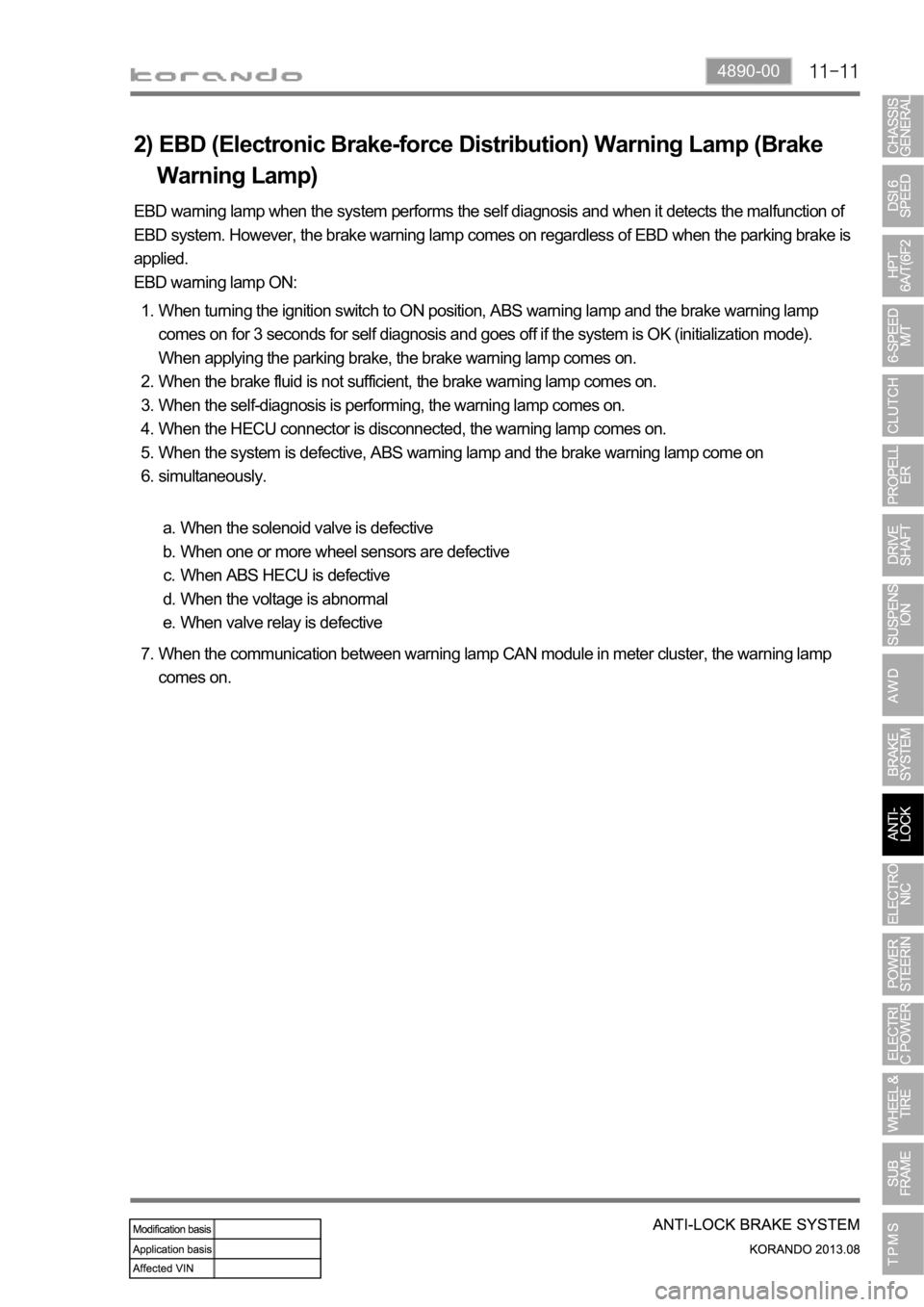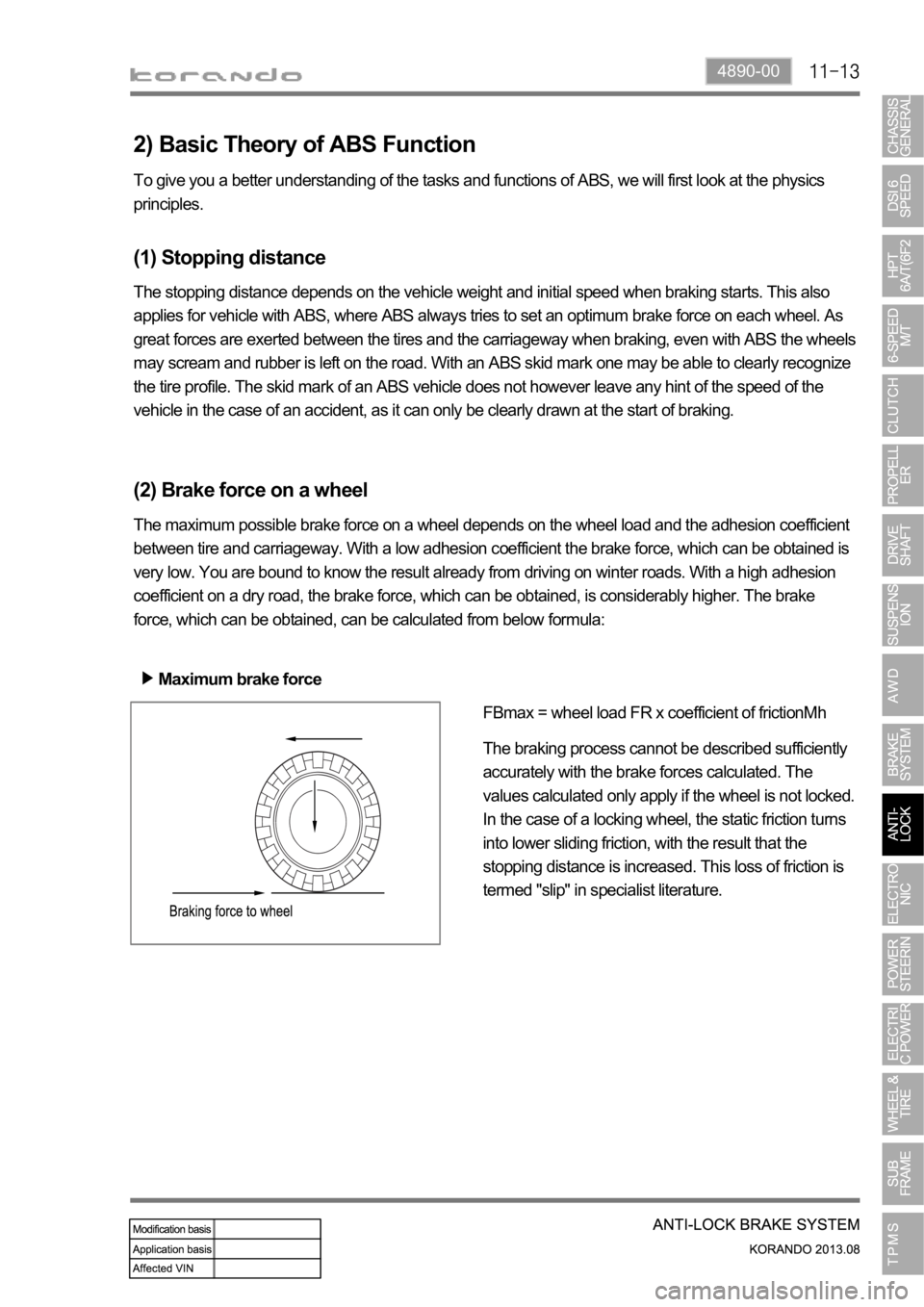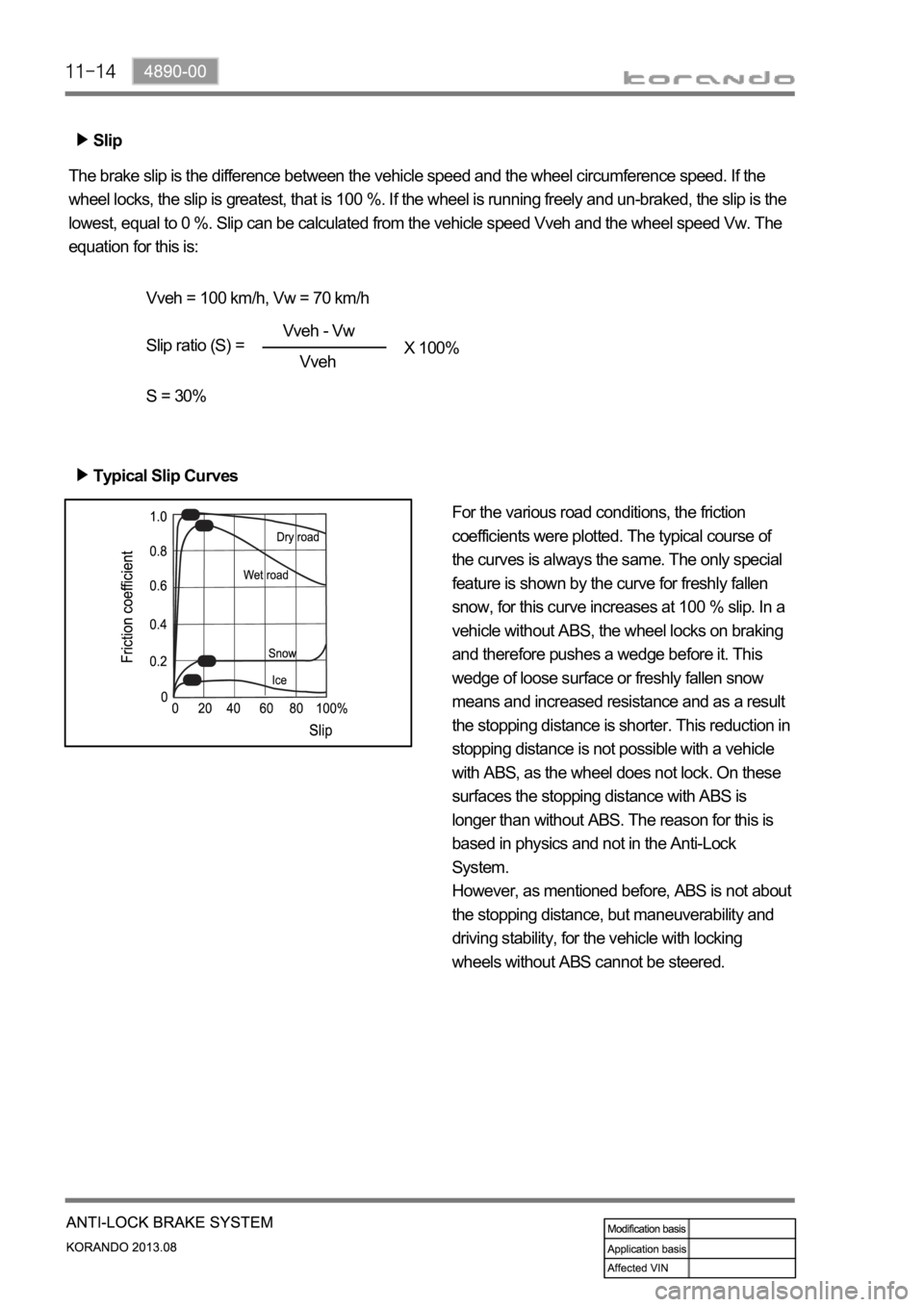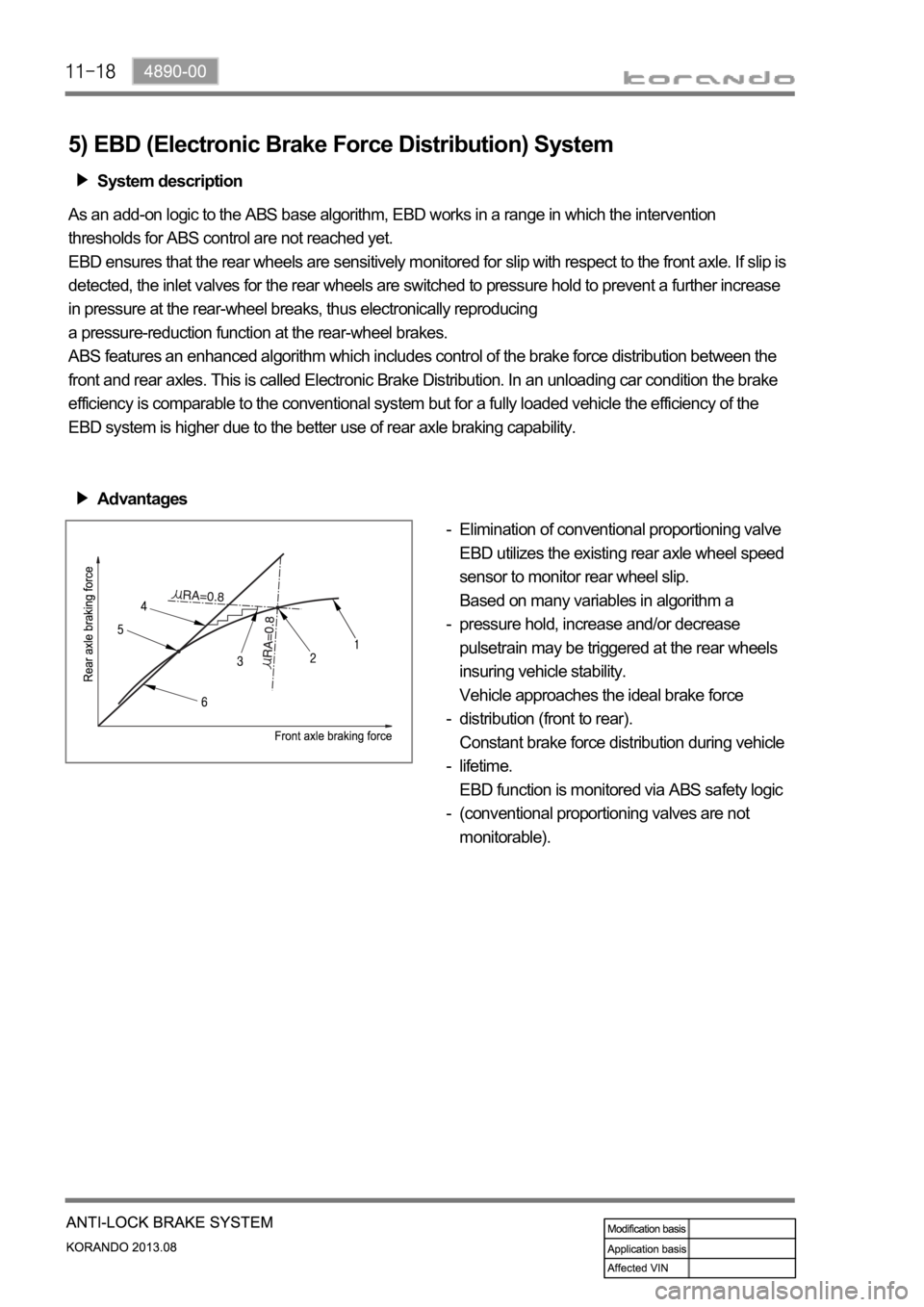Page 1105 of 1336
4890-00
3. ABS CONTROL LOGIC
The principal ABS control logic is the determination of the reference speed by choosing one wheel
meeting a certain condition, while sensing the speed information from 4 wheel speed sensors when the
vehicle is being driven.
For example, when the comparison of the reference speed with front right wheel speed shows a slip, the
control signal is determined according to whether it's deceleration or acceleration. If the control
conditions are met, the brake for the front right wheel will be got under control.
Page 1107 of 1336

4890-00
2) EBD (Electronic Brake-force Distribution) Warning Lamp (Brake
Warning Lamp)
EBD warning lamp when the system performs the self diagnosis and when it detects the malfunction of
EBD system. However, the brake warning lamp comes on regardless of EBD when the parking brake is
applied.
EBD warning lamp ON:
When turning the ignition switch to ON position, ABS warning lamp and the brake warning lamp
comes on for 3 seconds for self diagnosis and goes off if the system is OK (initialization mode).
When applying the parking brake, the brake warning lamp comes on.
When the brake fluid is not sufficient, the brake warning lamp comes on.
When the self-diagnosis is performing, the warning lamp comes on.
When the HECU connector is disconnected, the warning lamp comes on.
When the system is defective, ABS warning lamp and the brake warning lamp come on
simultaneously. 1.
2.
3.
4.
5.
6.
When the solenoid valve is defective
When one or more wheel sensors are defective
When ABS HECU is defective
When the voltage is abnormal
When valve relay is defective a.
b.
c.
d.
e.
When the communication between warning lamp CAN module in meter cluster, the warning lamp
comes on. 7.
Page 1109 of 1336

4890-00
2) Basic Theory of ABS Function
To give you a better understanding of the tasks and functions of ABS, we will first look at the physics
principles.
(1) Stopping distance
The stopping distance depends on the vehicle weight and initial speed when braking starts. This also
applies for vehicle with ABS, where ABS always tries to set an optimum brake force on each wheel. As
great forces are exerted between the tires and the carriageway when braking, even with ABS the wheels
may scream and rubber is left on the road. With an ABS skid mark one may be able to clearly recognize
the tire profile. The skid mark of an ABS vehicle does not however leave any hint of the speed of the
vehicle in the case of an accident, as it can only be clearly drawn at the start of braking.
(2) Brake force on a wheel
The maximum possible brake force on a wheel depends on the wheel load and the adhesion coefficient
between tire and carriageway. With a low adhesion coefficient the brake force, which can be obtained is
very low. You are bound to know the result already from driving on winter roads. With a high adhesion
coefficient on a dry road, the brake force, which can be obtained, is considerably higher. The brake
force, which can be obtained, can be calculated from below formula:
Maximum brake force
FBmax = wheel load FR x coefficient of frictionMh
The braking process cannot be described sufficiently
accurately with the brake forces calculated. The
values calculated only apply if the wheel is not locked.
In the case of a locking wheel, the static friction turns
into lower sliding friction, with the result that the
stopping distance is increased. This loss of friction is
termed "slip" in specialist literature.
Page 1110 of 1336

Slip
The brake slip is the difference between the vehicle speed and the wheel circumference speed. If the
wheel locks, the slip is greatest, that is 100 %. If the wheel is running freely and un-braked, the slip is the
lowest, equal to 0 %. Slip can be calculated from the vehicle speed Vveh and the wheel speed Vw. The
equation for this is:
Vveh = 100 km/h, Vw = 70 km/h
Slip ratio (S) =
For the various road conditions, the friction
coefficients were plotted. The typical course of
the curves is always the same. The only special
feature is shown by the curve for freshly fallen
snow, for this curve increases at 100 % slip. In a
vehicle without ABS, the wheel locks on braking
and therefore pushes a wedge before it. This
wedge of loose surface or freshly fallen snow
means and increased resistance and as a result
the stopping distance is shorter. This reduction in
stopping distance is not possible with a vehicle
with ABS, as the wheel does not lock. On these
surfaces the stopping distance with ABS is
longer than without ABS. The reason for this is
based in physics and not in the Anti-Lock
System.
However, as mentioned before, ABS is not about
the stopping distance, but maneuverability and
driving stability, for the vehicle with locking
wheels without ABS cannot be steered. Typical Slip Curves
Vveh - Vw
VvehX 100%
S = 30%
Page 1111 of 1336

4890-00
KAMM circle
Before we go into the Kamm circle, you should
know that a tire offers a maximum of 100 %
transmissibility. It is all the same for the tire
whether we require 100 % in the direction of
braking or in the direction of the acting lateral
force, e.g. when driving round curves. If we drive
into a curve too fast and the tire requires 100 %
transmissibility as cornering force, the tire cannot
transmit any additional brake force. In spite of the
ABS the car is carried out of the curve. The
relationship between brake force B and cornering
force S is shown very clearly in the Kamm circle. I
f
we put a vehicle wheel in this circle, the
relationship becomes even clearer. In this
relationship: as long as the acting forces and the
resulting force remain within the circle, the vehicle
is stable to drive. If a force exceeds the circle, the
vehicle leaves the road.
Brake force
When depressing the brake pedal the brake force
increases to the maximum, then the brake force
decreases until the wheel locks.
Cornering force
The cornering force is a maximum when the
wheel is turning freely with zero slip. When
braking the cornering force falls to zero if the
wheel locks (slip 100 %).
ABS operating range
The operating range starts just before the
maximum brake force and ends in maximum, for
the unstable range then begins, in which no
further modulation is possible. The ABS controls
the regulation of the brake pressure so that the
brake force only becomes great enough for a
sufficient proportion of cornering force to remain.
With ABS we remain in the Kamm circle as long
as the car is driving sensibly. We will leave driving
physics with these statements and turn to the
braking systems with and without ABS. -
-
- Brake and cornering force
Page 1112 of 1336
3) Basic ABS Control
Operation of ABS control unit
Applications of the ABS control unit The signals
produced by the wheel sensors are evaluated in
the electronic control unit. From the information
received, the control unit must first compute the
following variables:
Wheel speed
Reference speed
Deceleration
Slip -
-
-
-
Reference speed
The reference speed is the mean, I.e. average speed of all wheel speeds determined by simple
approximation.
Simplified ABS control
If, during braking, one wheel speed deviates from the reference speed, the ABS control unit attempts to
correct that wheel speed by modulating the brake pressure until it again matches the reference speed.
When all four wheels tend to lock, all four wheels speeds suddenly deviate from the previously
determined reference speed. In that case, the control cycle is initiated again in order to again correct the
wheel speed by modulating the brake pressure.
Page 1113 of 1336
4890-00
4) ABS Control Pattern
The ABS control is performed by comparing the reference speed with each wheel speed. Firstly, it is
determined whether the vehicle is in the deceleration or acceleration state using the wheel speed
change ratio. Then, a signal is transmitted to the valve.
Finally, the brake pressure is adjusted via the signal.
Page 1114 of 1336

5) EBD (Electronic Brake Force Distribution) System
System description
As an add-on logic to the ABS base algorithm, EBD works in a range in which the intervention
thresholds for ABS control are not reached yet.
EBD ensures that the rear wheels are sensitively monitored for slip with respect to the front axle. If slip is
detected, the inlet valves for the rear wheels are switched to pressure hold to prevent a further increase
in pressure at the rear-wheel breaks, thus electronically reproducing
a pressure-reduction function at the rear-wheel brakes.
ABS features an enhanced algorithm which includes control of the brake force distribution between the
front and rear axles. This is called Electronic Brake Distribution. In an unloading car condition the brake
efficiency is comparable to the conventional system but for a fully loaded vehicle the efficiency of the
EBD system is higher due to the better use of rear axle braking capability.
Advantages
Elimination of conventional proportioning valve
EBD utilizes the existing rear axle wheel speed
sensor to monitor rear wheel slip.
Based on many variables in algorithm a
pressure hold, increase and/or decrease
pulsetrain may be triggered at the rear wheels
insuring vehicle stability.
Vehicle approaches the ideal brake force
distribution (front to rear).
Constant brake force distribution during vehicle
lifetime.
EBD function is monitored via ABS safety logic
(conventional proportioning valves are not
monitorable). -
-
-
-
-